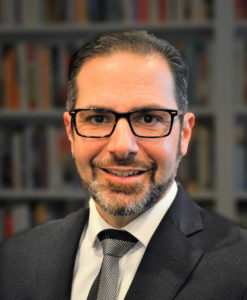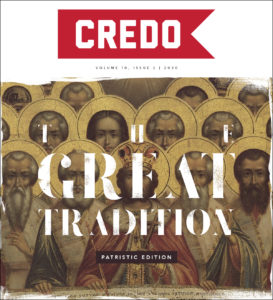As a former Roman Catholic, I watched the much-discussed Netflix film, The Two Popes, and experienced two competing emotions: a positive attraction to what I found authentically catholic, as well as a negative repulsion over what is provincially Roman.
The film is based on the premise that former Cardinal Jorge Bergoglio of Argentina visited the Vatican to tender his resignation to Pope Benedict XVI, only to find that Benedict himself was about to resign from the papacy. What follows is a heartwarming movie that combines biography with humorous flights of fancy. 
The response has been predictable. Left-leaning Jesuits such as James Martin “love it” as “beautifully written and perfectly acted.” And indeed, there is much to like. It stars veteran Welsh actors Jonathan Pryce and Anthony Hopkins. Pryce was nominated by the Academy of Motion Picture Arts and Sciences for Best Actor in a Leading Role, for his portrayal of Pope Francis. Hopkins was nominated as Best Supporting Actor for his depiction of Pope Benedict. The film also received a nomination for Best Adapted Screenplay.
Uncharitable and Unhistorical
But conservative-minded Roman Catholics have watched The Two Popes with “disquiet and anger,” mainly for its uncharitable portrait of Benedict XVI. Robert Barron, founder of Word on Fire Catholic Ministries and Auxiliary Bishop of the Archdiocese of Los Angeles, highlights some reasons for this disquiet, starting with the depiction of Cardinal Ratzinger as shamelessly campaigning among other Cardinals at the Vatican for his election as Pope in 2005. Barron points out that “on at least three occasions, the real Cardinal Ratzinger begged John Paul II to allow him to retire from his position as head of the Congregation for the Doctrine of the Faith and to take up a life of study and prayer. He stayed on only because John Paul adamantly refused the requests.”
Even worse is the mischaracterization that occurs toward the film’s conclusion. A spiritually despondent Benedict, bruised by the bureaucracy and scandal of the Vatican, admits that he no longer hears God’s voice in prayer but that his heart has become strangely warmed by his newfound friendship with Cardinal Bergoglio. Such windows into Benedict’s soul are almost mocking, especially as compared with the warm-hearted humanity and spiritual vibrancy of his visitor. In short, Benedict XVI is presented as pathetic, while Francis is a character you can’t help but love. As a former Roman Catholic, I watched the much-discussed Netflix film, The Two Popes, and experienced two competing emotions: a positive attraction to what I found authentically catholic, as well as a negative repulsion over what is… Share on X
It’s not too difficult to see in these characters the modern secular understanding of what is desirable in religion. Francis represents a liberal vision full of human warmth and authenticity that stands in opposition to the theologically precise and unchanging dogma of the conservative Benedict—particularly the variety that offends the sentimental and relativistic inclinations of post-Christian culture. The liberal vision should be celebrated, while the old, crusty, and dying dogmaticians should retire into silence. You get the point.
In addition to this divide, there are, I believe, two appropriate reactions that most Protestants will have when watching the film (at least those who were raised Roman Catholic). We’ll consider each in turn.
What Is Lovely
I must confess, there was much of this movie that I found endearing. While I’m no longer Roman Catholic (having converted to evangelical Protestantism twenty-five years ago) and find much of the unbiblical elements of Roman belief and practice to be stomach-churning, I nevertheless retain an affection for the genuinely Christ-centered heritage of the Great Tradition that underlies portions of Roman belief and practice—the revelation of Christ in Scripture, early creeds, prayers, proclamation, liturgy, and witness to the world. I experience such pointers to new creation life, whenever they emerge and shine forth, not as wickedness to be denounced but rather as evidence of Christ’s kingdom. The reasons for this are twofold: historical and personal.
Historical: When I look at the Sistine Chapel, for instance, I can’t help but think of the devout and laborious faith of Michelangelo that enabled him to create such stunning frescoes at the expense of his neck and spine. I think of Vittoria Colonna, the evangelical noblewoman and poet with whom the Florentine artist famously exchanged letters over so many years, who introduced Michelangelo to the writings of Protestant Reformers and who led him into the gospel preaching circles of the Spirituali, a reform movement within the sixteenth-century Roman church. I nevertheless retain an affection for the genuinely Christ-centered heritage of the Great Tradition that underlies portions of Roman belief and practice—the revelation of Christ in Scripture, early creeds, prayers, proclamation,… Share on X
During the film, during the pope’s extended discourse through the beautiful gardens of Castel Gandolfo, I envisioned the Italian countryside where Roman Catholic prelates gathered to study the Bible under the influence of evangelical leaders such as Juan de Valdés, Bernadino Ochino, and Peter Martyr Vermigli. Whether it was among the Spirituali in the city of Viterbo, or farther south in the environs of Naples, such gatherings became dynamic centers for gospel renewal. Pietro Carnesecchi, who was part of the Valdésian circle who met to study Scripture in the Neapolitan country, described these meetings as “regno di Dio” (the kingdom of God). Unfortunately, much of this history has been forgotten; but it happened, right there on the peninsula.
Personal: Having grown up as a son of the Roman Catholic Church and then, years later, working full time as a professional fundraiser in parishes and dioceses along the East Coast, I have been personally blessed by certain Catholic priests, especially from the pastoral care of Monsignor Tom, my childhood pastor who taught our family to love Jesus above all. I’ve enjoyed banter over coffee with priest friends in parish rectories—often debating theological tenets such as justification by faith—and playing rounds of golf during which Father so-and-so graciously walked with me through the tall grass looking for my lost ball (while his was on the green). I would be ungrateful to deny the many kindnesses that came my way from these friends.
Born and Bred within the Roman Church
To some Protestants, such expressions of gratitude for what I’ve received from the Roman Catholic tradition may sound like a compromise of Reformation principles. But we should remember that Calvin was unafraid to express such sentiments in his letter to Cardinal Sadoleto, stating that despite serious differences of doctrine, “[it doesn’t mean] that Roman Catholics are not also Christians. We indeed, Sadoleto, do not deny that those over which you preside are Churches of Christ.”[i] Along this line, Phil Ryken also offers a helpful reminder.
Sometimes we forget that Luther, Calvin, and the rest of the Reformers were born and bred within the Roman church. When Catholics were catholic, they were Catholic too, and it was within the Roman church that they came to saving faith in Jesus Christ. To be sure, the pope would not tolerate their plain teaching of the gospel, so eventually they were thrown out of the church. But God can and does carry out his saving work to this day, even where his gospel is not preached in all its clarity.[ii]
Disheartening Elements
But (and that is a strong Pauline adversative “but”) for all the historical and personal reasons one might appreciate The Two Popes, the film contains disheartening elements for Protestant viewers. These revolve, quite naturally, around the papal office itself and the institution of the church. We must not identify the Christian faith with any one person or institution, as in the case of the pope or the Roman Catholic Church, but instead look directly to the singular Savior who sits upon the Throne. Share on X
The office of the papacy is, needless to say, a huge stumbling block. You can’t look at the Sistine Chapel from a historical perspective, after all, without remembering Sixtus IV Della Rovere (the pope who built it and after whom it was named). Pope Sixtus maintained a thoroughgoing policy of nepotism and political subterfuge aimed at establishing himself as an Italian prince. It was he who arranged for the (failed) assassination of Lorenzo de’ Medici in Florence and who had Lorenzo’s brother killed in the Pazzi Conspiracy. In Sixtus, one sees the internal conflict of the papal office, which came to be regarded as simultaneously spiritual and political. This basic conflict was a main thread of the film, tying together the back story of Bergoglio’s questionable relationship to dictatorial power in Buenos Aires (between 1976 and 1983) and the recent history of Roman controversy concerning the Vatican Bank that is believed to have hastened Benedict XVI’s unexpected resignation.
On a more fundamental level, The Two Popes accepts without argument the Roman church’s theologically misguided position that the pope is the vicar of Christ, the earthly representative of the Lord. Christians who trust the Bible as the final authority on the Christian faith, however, acknowledge only one vicar of Christ (who infallibly represents Christ)—the Holy Spirit of God (John 14:26).
And then there’s the issue of the institutional form of the church. The Two Popes naturally assumes the basic Roman Catholic idea that Christ’s authority subsists in and extends through her teaching and sacramental life, and the notion that the incarnated presence of Jesus (the “head”) is manifested or prolongated in his Church (the “members”). Such a church-centered vision, however, with its emphasis upon the Pontifex Maximus and his magisterially accredited organs and oracles of salvation, offends the biblical emphasis on solus Christus—that our justification is based upon the redemptive work of Christ alone. The Two Popes is a remarkable piece of cinematic art that at once reflects some of the best and worst elements of Roman Catholicism. Share on X
A Balanced Way Forward?
It was Lord Acton (1834-1902) who memorably stated, “Power tends to corrupt, and absolute power corrupts absolutely,” a concern, it turns out, that sheds light on The Two Popes. It was, of course, against the backdrop of Pius IX’s inquisitions that Acton expressed this concern. Its applicability, therefore, to the dark side of Vatican politics is obvious. But it also reminds us that we must not identify the Christian faith with any one person or institution, as in the case of the pope or the Roman Catholic Church, but instead look directly to the singular Savior who sits upon the Throne.
Important as it is to remember Acton’s caution, Protestants should not feel obligated to plug their ears and cover their eyes in avoidance of anything that goes by the name Roman. Indeed, as I’ve suggested, there are some instructive lessons and pastoral inspirations to be gained from the Roman Catholic Church, inasmuch as its patterns of Christ-centered prayers, proclamation, liturgy, and witness elucidate the Great Tradition.
The Two Popes is a remarkable piece of cinematic art that at once reflects some of the best and worst elements of Roman Catholicism. By it a discerning viewer can glimpse some of the beauty of authentic catholicity and the ugliness of Rome’s misplaced theological hubris. May we who claim the mantle of biblical faith “Abhor what is evil; hold fast to what is good.”
Endnotes
[i] John Calvin and Jacopo Sadoleto, A Reformation Debate: Sadoleto’s Letter to the Genevans and Calvin’s Reply, ed. John. C. Olin (New York: Harper Torchbooks, 1966), 69.
[ii] Philip Ryken, My Father’s World: Meditations on Christianity and Culture (Phillipsburg, N.J.: P&R Publishing, 2002), 230–231.


